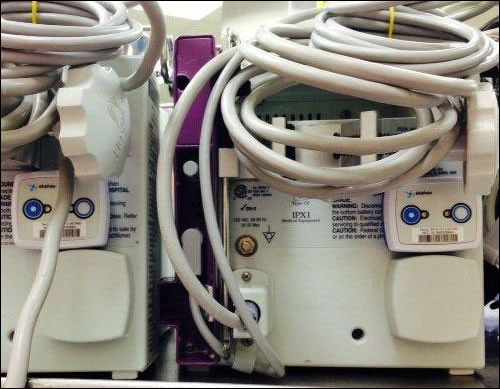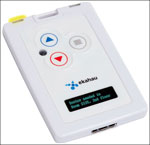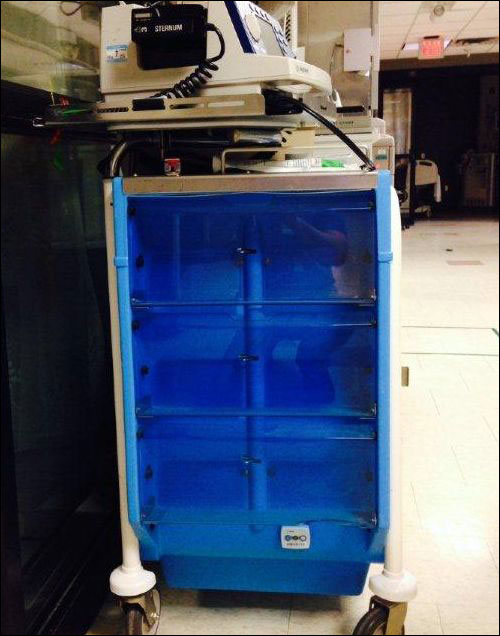Altru Hospital, an acute care and rehabilitation facility in Grand Forks, N.D., has installed a real-time location system (RTLS) that not only tracks assets, but also provides data regarding patients to visitors, security to some employees, and temperature conditions within some refrigerators. The system, provided by RTLS company Ekahau, includes Wi-Fi-based active RFID badges worn by visitors as they move through hundreds of distinct zones throughout the facility. Those tags are read via the hospital’s Wi-Fi network, and data related to the read events is managed on the Ekahau Vision software residing on the hospital’s server.
Altru Health Systems, which runs the hospital, along with several dozen clinics throughout North Dakota and Minnesota, serves 409,000 outpatients and 13,927 inpatients annually. Altru Hospital houses 277 patient beds and is adjoined by clinics and a rehabilitation center. In addition, says Clyde Strand, Altru Health’s biomedical engineering manager, Altru Health recently opened a new facility—the Altru Specialty Center—with 65 beds, also in Grand Forks but on a different campus, and the Wi-Fi badge tags are being used for visitor notification at that facility as well.
In 2011, the organization first began seeking an RTLS solution to help it track assets at Altru Hospital. Personnel were spending a great deal of time searching for standard and specialty beds, as well as wheelchairs, pumps and ventilators, throughout the 432,000-square-foot facility, either because nurses needed the equipment for a patient, or because the central processing department required those items for cleaning or maintenance.
According to Strand, Ekahau was the only RTLS company willing to go onsite and provide a live demonstration, and Altru was pleased with what it saw. The hospital launched the Ekahau Vision system that year, but found that its existing Wi-Fi network did not provide sufficient location data regarding items’ locations. For the solution to work well, Strand explains, the hospital required room-level accuracy, by means of the zones that the facility had set up (a zone could be a patient room or a laboratory, for example). That necessitated the triangulation of numerous Wi-Fi nodes throughout the hospital.
Consequently, Altru Health put the RTLS project on hold until it added Wi-Fi access points. It now has approximately 200 Cisco-provided access points in place, with the greatest density at the hospital itself, where the zones are smaller than in areas such as the clinics and rehabilitation areas. By 2013, the system was back in operation, tracking Ekahau active A4 Wi-Fi-based asset tags and B4 badge tags for employees who worked at the psychiatric ward or some of the clinics. The B4 badge can be worn in a person’s pocket, explains Mark Norris, Ekahau’s president and CEO, and has a ring that a wearer can pull to trigger an emergency alert. That alert would then be forwarded to other B4 badges worn by the security staff, and would also be displayed on management’s computers (in both cases, indicating where the emergency was occurring). About 12 security badges are now in use, Strand says.
The hospital currently has approximately 900 Ekahau A4 asset tags on intravenous pumps, code-blue crash carts, beds and wheelchairs. The tags are being used not only for real-time location tracking, but also for par-level monitoring. For example, Strand says, the Ekahau Vision software has been programmed to identify if three or more of a specific item type—such as an IV pump—enter the dirty utility room. At that time, an alert is sent to authorized personnel to collect the equipment and move the items to the cleaning or maintenance areas. The hospital can also analyze the data in order to determine where and how often the equipment is used. If it finds, for instance, that IV pumps are being utilized more often on a specific floor, management can then route a larger number of those pumps to that floor on a regular basis.
The hospital rents some equipment, including specialty beds, from other companies, to ensure that sufficient equipment is always on hand for patient use. However, Strand says, with better information regarding how those items are being used, costs can be reduced—for example, by reducing the number of specialty beds that need to be rented, since the hospital now knows the exact number available.
One challenging aspect of the installation, Norris reports, involved providing location-based data for hundreds of zones. “For these zones to be effective, they must be truly representative of the nomenclature in use in the facility,” he says. “This involved working very closely with Altru staff and system owners, to ensure these zones aligned with current day-to-day activity at the site.”
This year, Altru Health began providing B4 badge tags to visitors, for use as notification devices. The main hospital uses about six such tags, and so does the Altru Specialty Center, since opening this past March. When family members or friends accompany a patient to either of the two facilities, they receive a B4 badge tag, which comes with an LED screen that can display text messages. As the patient moves from one process to another—while leaving surgery, for instance—staff members input that information into the Vision software, which is then displayed on the LED screen of a patient’s visitors badge tag, such as “Patient 33 in post-op room 202.”
The hospital has also installed three Ekahau TS2 temperature-sensing tags to monitor the conditions inside medication refrigerators within its pharmacy and cancer center. The TS2 tag, mounted to a refrigerator’s exterior, has a wired sensor probe that is installed inside the unit in which temperature levels are being measured. Strand says the hospital has approximately 200 such refrigerators in which sensor-based data would be useful. However, he is waiting for Ekahau to release a wireless sensor tag that could be attached to an item stored within a refrigeration unit, and thus does would not need to be attached to the unit with a probe inserted into the machine. This, he says, would make it easier to move units and continue tracking the temperatures within.
Additionally, the hospital is evaluating the use of Ekahau infrared beacons to provide more specific location data for areas in which Altru Health may need to know in which part of a room a particular tag is located. Each beacon transmits its unique ID number via an IR signal, and a Wi-Fi tag within range of that signal forwards that beacon’s ID back to the Vision software, which can identify the specific zone in which that tag is located.
Strand says he is also interested in using asset-tracking tags at the Altru Specialty Center, though that is not yet happening. What’s more, he is considering utilizing Ekahau tags to monitor patients’ location in real time.
At this time, Strand says he has not conducted any analysis regarding how much time or cost is being saved thanks to the new technology. “It’s still progressing right now,” he states, “but there are people using the system and liking it.” The visitor badges have been especially popular, he adds, as they enable guests to move around the facility while waiting for a patient, rather than having to remain in the waiting room to learn any status updates.
In the future, Strand also plans to employ the technology to track laptop computers. No tag would be necessary for that application, he notes—rather the hospital would simply install software on each laptop itself to prompt the machine to transmit its unique identifier to the Vision system.





